2009 Sea-Doo GTX Limited iS 255 Review
Sea-Doo introduces ambitious new craft
Leave it to Sea-Doo to think big. More than any other manufacturer, Sea-Doo has consistently pushed the PWC industry forward with new performance benchmarks and innovative product ideas. For 2009, the Canadian company brings an unprecedented level of technology to the water, ideas that solve problems most PWC riders didn’t know they had.
Did you ever imagine riding a PWC with ride-softening suspension? Or wish you had a brake to stop faster? Me either. Sea-Doo, however, imagined both these features and brings them to market on its new GTX Limited iS.
Most of the technology on the GTX Limited iS 255 relies on the brain power of an on-board computer that Sea-Doo calls iControl, which integrates the suspension system, drive-by-wire throttle functions, GPS-based speed control, off-throttle steering and the braking function. The iS suspension system is perhaps the most dramatic element of the entire iControl package. It consists of a pair of pivoting, cast-aluminum arms that support the upper deck – seat and footwells, handlebars and bow stowage compartment – above the hull and deck, which remain bonded together in traditional fashion. The aft suspension arm is visible below the rear grab handle, while the forward arm is hidden within the hull and is mated to the upper deck through a rubber bellows on each side that allows it to move through its six-inch range of travel. The actual suspension consists of a Fox gas-charged shock absorber and a coil spring, located side-by-side in the bilge and acting only on the forward arm. A hydraulic motor, managed by iControl, changes the spring pre-load and ride height.
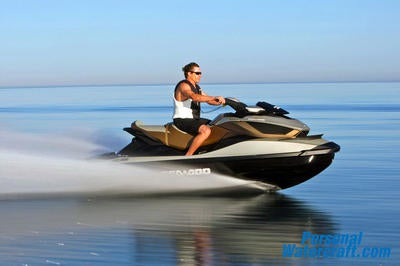 The GTX iS isolates the entire upper deck – from the bow stowage compartment to the seat and footwells – on a spring-and-shock suspension above the hull. Suspension tuning and the deep seat are intended for long-range touring.
The GTX iS isolates the entire upper deck – from the bow stowage compartment to the seat and footwells – on a spring-and-shock suspension above the hull. Suspension tuning and the deep seat are intended for long-range touring.The iS experience begins when you start it up. With the engine off, the suspension system is programmed to settle all the way down, for better stability and easier towing. Fire up the engine and the suspension rises about four inches, lifting the ‘rider environment’ with it. The suspension has six inches total travel, but is set up to use four of those inches for compression and two for rebound damping. In its auto mode, the suspension is adaptive – it senses the weight of rider and passenger on the seat, and uses the hydraulic motor to adjust pre-load accordingly. When underway, iControl monitors suspension travel, and if the suspension bottoms out it will add preload to stiffen the spring action. Ride onto a calmer area, and the suspension will automatically go back to a softer setting. There is also a manual mode, which allows the rider to select one of nine pre-load settings using a rocker switch on the left handlebar. In the manual mode, the pre-load stays fixed at the selected setting.
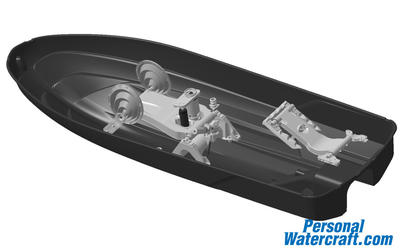 This graphic shows the two components of Sea-Doo’s suspension, including the location of the spring and shock relative to the front suspension.
This graphic shows the two components of Sea-Doo’s suspension, including the location of the spring and shock relative to the front suspension.The iS system does not turn the GTX into a magic carpet floating over the water. You’ve got four inches of compression travel under your feet, which is not going to suck up a two-foot chop. The effect of iS is to take the edge off of rough water. Experienced riders will notice that the full impact of the hull slapping through crisp waves is not transferred through the footwells and handlebars. And you can look down at the footwell area and see the upper deck moving up and down within the hull/deck. Passengers will especially appreciate iS – I found the ride to be softer and less jarring in the back seat. In my test of pre-production models two weeks ago on Pensacola Bay in Florida, I was happy to leave iS in its auto mode. Jumping back and forth between a GTX iS and a standard GTX Limited highlighted the effect of the suspension.
Brake Down
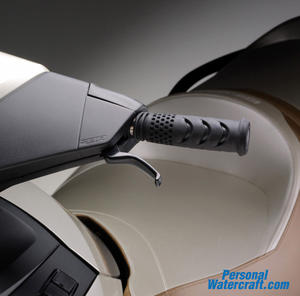 This lever on the left handlebar controls both the braking function and reverse selection on the Sea-Doo GTX Limited iS.
This lever on the left handlebar controls both the braking function and reverse selection on the Sea-Doo GTX Limited iS.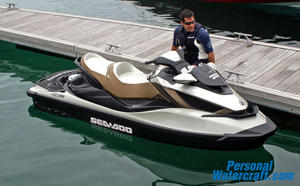 Sharp edges and angular styling still flows along the length of the Sea-Doo GTX Limited iS. The black deflector on the nose is intended to knock down bow spray when braking.
Sharp edges and angular styling still flows along the length of the Sea-Doo GTX Limited iS. The black deflector on the nose is intended to knock down bow spray when braking.The Sea-Doo iBR (intellgent brake and reverse) system is the first attempt I’ve seen to apply an active brake to a boat of any type. It’s controlled by a lever on the left handlebar that activates an electric motor, which then drops the reverse bucket. Like a jet aircraft, the GTX iS uses reverse thrust as a brake. Years ago we used to drop the reverse bucket on PWC and jet boats just for fun. The iBR system is a little more sophisticated. Working through iControl, a pull on the brake lever causes the engine to throttle down for a split-second so the reverse bucket can pivot down. The engine is then throttled back up to create reverse thrust, with rpm limited to about 3500, so there’s not so much braking effect that the rider is pitched over the bow. Hold the lever tight, and the bow will dive and you will get wet as as wave of water washes over the cowl. But your stopping distance from 55 mph will be reduced by 33 to 50 percent, according to Sea-Doo.
At the media intro, I rode the GTX iS side-by-side with a standard GTX, and we both let off the throttle at a marker in the water. Using the brake, I stopped in about half the distance it took the standard GTX to coast down. The brake is not an on/off switch, however. You can modulate the lever and control the reverse thrust enough to avoid getting wet. The brake is so effective that Sea-Doo does not equip the GTX Limited iS with its OPAS off-power steering rudder system.
The same brake lever also controls the reverse function of the GTX iS. When you start the boat, the iControl system selects a ‘neutral setting for the reverse bucket that is startlingly effective – in my test the GTX iS did not move at all in neutral, so there’s no more issue with the boat moving away as soon as you start the engine. To engage reverse, you simply grip the brake lever, and then use the throttle to control thrust. When you release the lever, the neutral setting is engaged. Touch the throttle, and the system ‘shifts’ into forward. Flick the brake lever, and you are back in neutral. The system delivers instant control, and keeps both of the driver’s hands on the handlebars at all times. And it’s intuitive to use. It took me just a few cycles to get used the process. Of all the features on the new GTX iS, I think the iBR system will be the most appealing to any rider. Expect to see iBR trickle down the Sea-Doo product line.
Even More Technology
Suspension and brakes are just the beginning of the innovation on the GTX iS. A drive-by-wire throttle uses no cable and through iControl enables two speed-control functions, one for no wake zones that can be set up to seven mph, and a cruise-control system that will hold the boat at any speed. Both are linked to a GPS speedometer, rather than to engine rpm as is the case on the Yamaha SHO. The Sea-Doo speed control also remembers your previous setting, so if you need to stop for a dropped wakeboarder, for example, you can just squeeze the throttle and go right back to the pre-set speed. The GPS and iControl are also used to limit the top speed of the GTX iS to 65 mph, a feature that will please the United States Coast Guard.
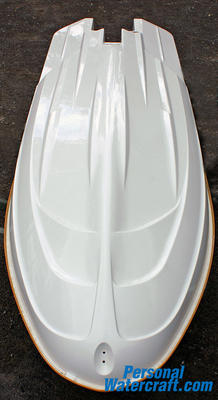 The new hull is formed in a closed-mold process and shaves 50 pounds off its weight.
The new hull is formed in a closed-mold process and shaves 50 pounds off its weight.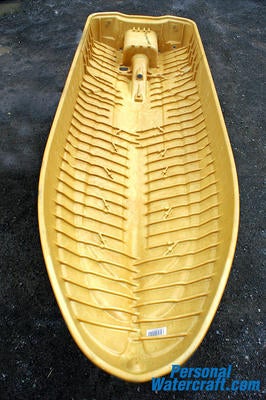 The inner surface of the hull is smooth with a series of ribs that stiffen the structure for added strength.
The inner surface of the hull is smooth with a series of ribs that stiffen the structure for added strength.The GTX iS also debuts a brand-new hull called the S3, which is formed of a new fiberglass-reinforced material in a closed-mold process that Sea-Doo says cuts the hull weight by 50 pounds, compared to the same part made of open-mold fiberglass. The inner hull surface is heavily ribbed for stiffness, while the running surface has a step aft the pump intake designed to reduce drag. A deep deadrise of 22 degrees softens the ride but leaves the boat a little less stable at rest than the previous GTX. This hull is designed to bank into a turn. Despite the light-weight hull, the GTX iS has a hefty dry weight of 948 pounds, compared to 803 pounds for the 2009 Sea-Doo GTX 215. The new hull is 11’ 7” long, or 9” longer than the previous GTX models.
Other new features include an instrument panel that moves up and down with the adjustable handlebars. The instrument display now includes a GPS-based compass heading display and a fuel consumption data display. The Learning Key function is now controlled by the owner, who can program both the top speed limit and rate of acceleration. The glove box is deeper than on previous GTX models, and there’s a new stowage compartment under the boarding platform that could hold a ski line. Access to the battery is also through this compartment. The seat is fixed to the deck with a hinge on its forward end, and rises on a gas strut. When you lift the seat, instead of the engine you see a sealed hatch in the top of the deck that is removed to reach the motor for routine service. It’s nice to not have to lift off the seat, but engine access is not as good as on previous models. Finally, the GTX iS is equipped with Speed Ties, retractable mooring lines on the stern and the cowl that pull out and then zip back into the deck.
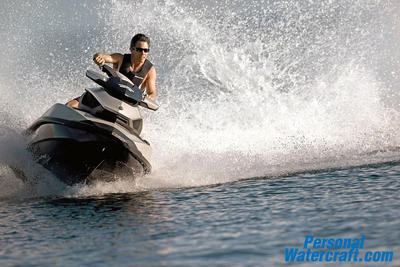 The new hull has a very deep-vee profile, and is designed to lean into turns.
The new hull has a very deep-vee profile, and is designed to lean into turns.The drivetrain of the GTX iS is familiar, the same supercharged/intercooled Rotax Marine 1.5-liter triple-cylinder engine, rated by Sea-Doo at 255 hp, that debuted last year on the RXT-X and RXP-X models. This engine’s closed-cooling system is a bonus for salt-water use. Fuel capacity is 18.6 gallons, a nice increase over the 15.9-gallon tank in the previous GTX Limited, but not exactly generous given this boat’s horsepower and touring intentions. The GTX iS also has the programmable electric VTS trim system used on the RXT-X.
Sea-Doo’s new innovations won’t exactly come cheap as the GTX iS will retail for $16,499. It’s impossible to make a complete summary of the craft because the examples I tested in Pensacola were $100,000, hand-built validation prototypes that needed some tweaking. The electronic control for the suspension system crashed and had to be “re-booted” a few times, and I thought the progressive throttle was too abrupt. The brake needs more tension. The edges of the ‘rider environment’ chafed and squeaked against the deck as the suspension moved up and down. And all of the GTX iS craft I rode listed slightly to starboard, a sign that Sea-Doo needs to work out some weight distribution issues. We’ll see if these matters are addressed when production boats are available at dealers in the spring. Time will also reveal whether all of the electronic controls can function reliably in a marine environment.)
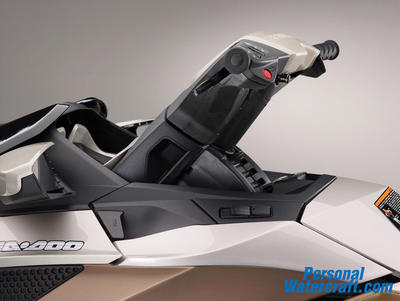 GTX Limited iS dash features an instrument pod that moves up and down with the adjustable handlebars to keep gauges in view of the rider.
GTX Limited iS dash features an instrument pod that moves up and down with the adjustable handlebars to keep gauges in view of the rider.If you are coming off a Sea-Doo GTX, or another brand of luxury-touring PWC, the GTX iS will feel a little tippy in the water, as Sea-Doo has sacrificed some stability at rest for the softer ride of the deep-vee hull. Underway, I felt every pound of this craft’s weight, as well. It’s clear there is a lot of mass under you when the water is rough. I think the suspension feature will appeal mostly to owners who frequently face choppy water conditions. The brake/reverse system, on the other hand, is a fantastic innovation. As a whole, the GTX iS may be the most ambitious new product I’ve ever experienced.
| Sea-Doo GTX Limited iS 255 Specs | |
| Length | 139 inches |
| Beam | 48 inches |
| Dry Weight | 948 lbs |
| Engine | Three-cylinder EFI, Supercharged/Intercooled |
| Displacement | 1,494 cc |
| Bore and Stroke | 100mm x 63.4mm |
| Compression Ratio | 8.4:1 |
| Rated Horsepower | 255 |
| Fuel Capacity | 18.6 gal. |
| Combined Stowage Capacity | 16.4 gal. |
| Price | $16,499 |
Get PersonalWatercraft.com in your Inbox!
Like PersonalWatercraft.com on Facebook
Comments
Most Popular

Remembering the Sea-Doo XP

2025 Yamaha JetBlaster PRO 2-Up Review

2024 Yamaha GP HO Review

2008 Kawasaki Jet Ski Ultra 250X Review

2024 Kawasaki Jet Ski STX 160X Review
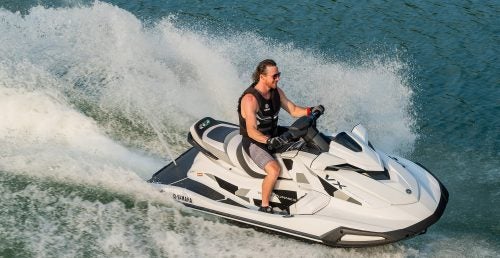










 Your Privacy Choices
Your Privacy Choices